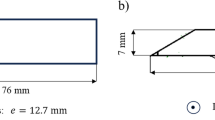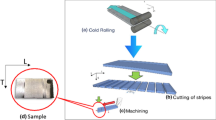Abstract
Cutting performance and wear mechanism of spark plasma-sintered Si3N4 (SN91) and Si3N4/WC (SW10) ceramic tools in the dry turning of 41Cr4 hardened steel are studied. SN91 tool shows better wear resistance than SW10 tool and commercial ceramic tool SW500 and cemented carbide tool YG8 under the same cutting conditions. The better cutting performance of SN91 can be attributed to its excellent high-temperature flexural strength. The most significant factor affecting the tool life of SN91 is the cutting speed. A higher material removal volume can be achieved at a low cutting speed, large depth of cut, and large feed rate. A long cutting distance/time can be achieved at a low cutting speed, small depth of cut, and feed rate. At a cutting speed of 103.62 m/min (ap = 0.1 mm, and f = 0.05 mm/rev), the wear mechanisms of SN91 are adhesion, oxidation, and diffusion, and no crater wear is observed on the rake face. At a cutting speed of 214.31 (ap = 0.3 mm and f = 0.05 mm/rev) and 314 m/min (ap = 0.2 mm and f = 0.05 mm/rev), the failure forms of SN91 tool are mainly rake face crater wear and flank wear; the wear mechanisms of rake face are diffusion, abrasion, and oxidation; and the wear mechanisms of flank face are abrasion, adhesion, and oxidation. The failure forms of SW10 tool are mainly rake face crater wear and flank wear, and the wear mechanisms are diffusion, abrasion, adhesion, and oxidation.











Similar content being viewed by others
References
Tian X, Yan K, Liu H et al (2019) Effect of Co on thermal and mechanical properties of Si3N4 based ceramic tool material. Ceram Int 45:19435–19441. https://doi.org/10.1016/j.ceramint.2019.06.198
Bocanegra-Bernal MH, Matovic B (2010) Mechanical properties of silicon nitride-based ceramics and its use in structural applications at high temperatures. Mater Sci Eng A 527:1314–1338. https://doi.org/10.1016/j.msea.2009.09.064
Belmonte M, González-Julián J, Miranzo P, Osendi MI (2010) Spark plasma sintering: a powerful tool to develop new silicon nitride-based materials. J Eur Ceram Soc 30:2937–2946. https://doi.org/10.1016/j.jeurceramsoc.2010.01.025
Maros BM, Németh AK, Károly Z et al (2015) Tribological characterisation of silicon nitride/multilayer graphene nanocomposites produced by HIP and SPS technology. Tribol Int 93:269–281. https://doi.org/10.1016/j.triboint.2015.08.041
Guo WM, Wu LX, Ma T et al (2015) Chemical reactivity of hot-pressed Si3N4-ZrB2 ceramics at 1500-1700°C. J Eur Ceram Soc 35:2973–2979. https://doi.org/10.1016/j.jeurceramsoc.2015.04.031
Miyazaki H, Hyuga H, Yichi Y et al (2009) Correlation of wear behavior and indentation fracture resistance in silicon nitride ceramics hot-pressed with alumina and yttria. J Eur Ceram Soc 29:1535–1542. https://doi.org/10.1016/j.jeurceramsoc.2008.08.020
Tapasztó O, Kun P, Wéber F et al (2011) Silicon nitride based nanocomposites produced by two different sintering methods. Ceram Int 37:3457–3461. https://doi.org/10.1016/j.ceramint.2011.05.150
Liu T, Jiang C, Guo W (2017) Effect of CeO2 on low temperature pressureless sintering of porous Si3N4 ceramics. J Rare Earths 35:172–176. https://doi.org/10.1016/S1002-0721(17)60896-2
Liu S, Ye F, Hu S et al (2015) A new way of fabricating Si3N4 ceramics by aqueous tape casting and gas pressure sintering. J Alloys Compd 647:686–692. https://doi.org/10.1016/j.jallcom.2015.05.134
Xu W, Yin Z, Yuan J et al (2017) Effects of sintering additives on mechanical properties and microstructure of Si3N4 ceramics by microwave sintering. Mater Sci Eng A 684:127–134. https://doi.org/10.1016/j.msea.2016.12.031
Alem A, Pugh MD, Drew RAL (2015) Reaction bonded silicon nitride foams: the influence of iron disilicide on microstructure and mechanical strength. Ceram Int 41:4966–4974. https://doi.org/10.1016/j.ceramint.2014.12.060
Logesh G, Lodhe M, Balasubramanian M (2017) Effect of temperature and gaseous medium on the evolved microstructures of carbon fiber reinforced reaction bonded silicon nitride composites. Ceram Int 43:6110–6116. https://doi.org/10.1016/j.ceramint.2017.02.004
Khajelakzay M, Bakhshi SR, Borhani GH, Ramazani M (2016) Synthesis and spark plasma sintering of the α- Si3N4 nanopowder. Ceram Int 42:14867–14872. https://doi.org/10.1016/j.ceramint.2016.06.123
Peng G, Li X, Liang M et al (2009) Spark plasma sintered high hardness α/β Si3N4 composites with MgSiN2 as additives. Scr Mater 61:347–350. https://doi.org/10.1016/j.scriptamat.2009.04.007
Tatli Z, Çalişkan F, Butler J et al (2014) SPS sintering of silicon nitride with fluoride additive. Ceram Int 40:1399–1404. https://doi.org/10.1016/j.ceramint.2013.07.021
Ahmad N, Sueyoshi H (2011) Microstructure and mechanical properties of silicon nitride-titanium nitride composites prepared by spark plasma sintering. Mater Res Bull 46:460–463. https://doi.org/10.1016/j.materresbull.2010.11.021
Cao L, Wang Z, Yin Z et al (2018) Investigation on mechanical properties and microstructure of silicon nitride ceramics fabricated by spark plasma sintering. Mater Sci Eng A 731:595–602. https://doi.org/10.1016/j.msea.2018.06.093
Wang Z, Jia J, Cao L et al (2019) Microstructure and mechanical properties of spark plasma sintered Si3N4/WC ceramic tools. Materials 2019(12):1868. https://doi.org/10.3390/ma12111868
Yin Z, Yan S, Ye J et al (2019) Cutting performance of microwave-sintered sub-crystal Al2O3/SiC ceramic tool in dry cutting of hardened steel. Ceram Int 45:16113–16120. https://doi.org/10.1016/j.ceramint.2019.05.128
Cheng Y, Hu H, Sun S, Yin Z (2016) Experimental study on the cutting performance of microwave sintered Al2O3/TiC ceramic tool in the machining of hardened steel. Int J Refract Met Hard Mater 55:39–46. https://doi.org/10.1016/j.ijrmhm.2015.11.006
Zhang Y, Cheng Y, Hu H, Yin Z (2017) Experimental study on cutting performance of microwave sintered Ti(C, N)/Al2O3 cermet tool in the dry machining of hardened steel. Int J Adv Manuf Technol 91:3933–3941. https://doi.org/10.1007/s00170-017-0062-2
Chong X, Huang C, Xu L et al (2012) Study on wear performance of whisker-toughening ceramic cutting tools synthesized by the carbothermal reduction process. Appl Mech Mater 121-126:3555–3558. https://doi.org/10.4028/www.scientific.net/AMM.121-126.3555
Wang J, Cheng Y, Zhang Y et al (2017) Friction and wear behavior of microwave sintered Al2O3/TiC/GPLs ceramic sliding against bearing steel and their cutting performance in dry turning of hardened steel. Ceram Int 43:14827–14835. https://doi.org/10.1016/j.ceramint.2017.07.231
Liu W, Chu Q, He R et al (2018) Preparation and properties of TiAlN coatings on silicon nitride ceramic cutting tools. Ceram Int 44:2209–2215. https://doi.org/10.1016/j.ceramint.2017.10.177
Wang Y, Zou B, Huang C et al (2019) Feasibility study of the Ti(C7N3 )-based cermet micro-mill based on dynamic fatigue behavior and modeling of the contact stress distribution on the round cutting edge. Int J Mech Sci 155:143–158. https://doi.org/10.1016/j.ijmecsci.2019.02.038
Wang Y, Zou B, Wang J et al (2020) Effect of the progressive tool wear on surface topography and chip formation in micro-milling of Ti–6Al–4V using Ti(C7N3)-based cermet micro-mill. Tribol Int 141:105900. https://doi.org/10.1016/j.triboint.2019.105900
Wang Y, Zou B, Huang C (2019) Tool wear mechanisms and micro-channels quality in micro-machining of Ti-6Al-4V alloy using the Ti(C7N3)-based cermet micro-mills. Tribol Int 134:60–76. https://doi.org/10.1016/j.triboint.2019.01.030
Zou B, Huang C, Song J et al (2011) Cutting performance and wear mechanism of Si3N4-based nanocomposite ceramic cutting tool in machining of cast iron. Mach Sci Technol 15:192–205. https://doi.org/10.1080/10910344.2011.580698
Zheng G, Zhao J, Zhou Y (2012) Friction and wear behaviors of Sialon-Si3N4 graded nano-composite ceramic materials in sliding wear tests and in cutting processes. Wear 290-291:41–50. https://doi.org/10.1016/j.wear.2012.05.020
Zheng G, Zhao J, Gao Z, Cao Q (2012) Cutting performance and wear mechanisms of Sialon-Si3N4 graded nano-composite ceramic cutting tools. Int J Adv Manuf Technol 58:19–28. https://doi.org/10.1007/s00170-011-3379-2
Lü Z, Deng L, Tian Q, Zhao X (2018) Cutting performance of Si3N4/TiC micro-nanocomposite ceramic tool in dry machining of hardened steel. Int J Adv Manuf Technol 95:3301–3307. https://doi.org/10.1007/s00170-017-1259-0
Tian X, Zhao J, Wang X et al (2018) Performance of Si3N4/(W, Ti)C graded ceramic tool in high-speed turning iron-based superalloys. Ceram Int 44:15579–15587. https://doi.org/10.1016/j.ceramint.2018.05.222
Chen Z, Li Z, Li J et al (2019) 3D printing of ceramics: a review. J Eur Ceram Soc 39:661–687. https://doi.org/10.1016/j.jeurceramsoc.2018.11.013
Liu X, Zou B, Xing H, Huang C (2020) The preparation of ZrO2-Al2O3 composite ceramic by SLA-3D printing and sintering processing. Ceram Int 46:937–944. https://doi.org/10.1016/j.ceramint.2019.09.054
Zhou M, Liu W, Wu H et al (2016) Preparation of a defect-free alumina cutting tool via additive manufacturing based on stereolithography-optimization of the drying and debinding processes. Ceram Int 42:11598–11602. https://doi.org/10.1016/j.ceramint.2016.04.050
Funding
This study was funded by the National Key R&D Program of China (grant number 2018YFB2002200), National Natural Science Foundation of China (grant number 51775280), Excellent Youth Foundation of Jiangsu Province of China (grant number BK20190070), and Jiangsu Provincial Six Talent Peaks Project (grant number 2016-HKHT-019).
Author information
Authors and Affiliations
Corresponding authors
Additional information
Publisher’s note
Springer Nature remains neutral with regard to jurisdictional claims in published maps and institutional affiliations.
Rights and permissions
About this article
Cite this article
Wang, Z., Sun, N., Cao, L. et al. Cutting performance and wear mechanism of spark plasma–sintered silicon nitride ceramics tool in dry turning of 41Cr4 hardened steel. Int J Adv Manuf Technol 107, 3415–3424 (2020). https://doi.org/10.1007/s00170-020-05277-y
Received:
Accepted:
Published:
Issue Date:
DOI: https://doi.org/10.1007/s00170-020-05277-y




